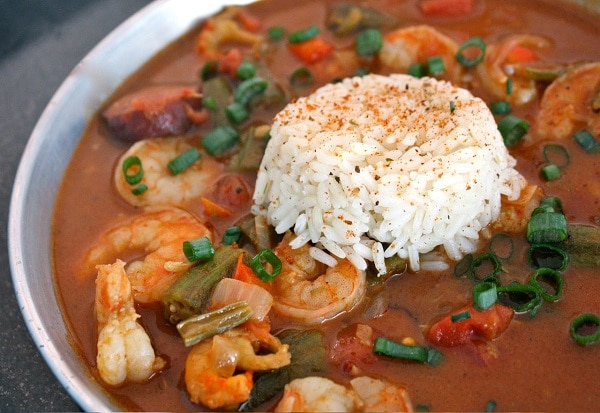
Last week I was scheduled for a breakfast meeting at LA’s 101 Coffee Shop. Though I’ve spent quite a bit of time in the City of Angels, I always feel like a fish out of water when traversing her sea of people and roadways. It was a very important meeting, and I was running late. I hate being late.
As usual, most of my unease was instantly quelled with a few bites of food, specifically the corned beef hash. So, it startled me a bit when the producer I was meeting with tried to once again knock me out of my comfort zone by asking a question dreaded by most chefs: “What’s your favorite meal?”
I think he was taken aback at the speed and efficiency of my one-word response: Gumbo.
A dish beloved by many, everyone has an opinion or two on its origins and proper make. Some believe gumbo is the natural product of French-Acadian recipe evolution – in other words, a remake of the classic French bouillabaisse, simply prepared with the ingredients made locally available in the exiled territory of Louisiana. Others attribute its origins to the Bantu-speaking West Africans, whose word ki-ngombo stands for one of the dish’s most prevalent ingredients, okra. The Choctaw Indians also get thrown into the mix for their kombo, or ground sassafras, another popular ingredient known in today’s terms as filé. Instead of espousing my historical opinion – a fight I know I’ll never win – I’d rather discuss more important matters, such as taste. And trust me, gumbo tastes damn good.
I’ll come clean: I’m not from Louisiana, nor do I have any Creole or Cajun ancestors. As a matter of respect, I’ll always bow down to those who do: y’alls gumbo is better than mine as a matter of principle. To put that statement into context, it’s like having some Californian tell me that they make a better version of Georgia Brunswick stew. For the Coloradans, it’s having a Texan tell you they prepare a better pork green chili. Ain’t gonna happen.
With that being said, I’ve been very fortunate to spend quite a bit of time in the great state of Louisiana, having traveled her gumbo trail from New Orleans to Lafayette, passionately spending over a decade there of cooking and appreciating the unique food spawned from this culture and region. From the native chefs, to the folks in the bayou swamps, to my friend’s 95-year-old grandma (who preferred to divulge her recipe in French), I’m darn proud of my outsider knowledge of this incredible creation.
The truth of the matter is that there are as many versions of gumbo as there are cooks. I’ll paraphrase a prior statement I once made about BBQ: try to get ten different folks from Louisiana to agree on the proper way to make gumbo, and you are likely to receive ten different, fiercely debated responses.
The debate includes, but is not limited to: The proper roux – its ingredients, color, and make. To use tomato (Creole) or not (Cajun). Okra vs. filé (never both). Andouille sausage, period. Stocks, seasonings, and contents. And finally rice or potato salad.
Confused? Good.
Welcome to the world of gumbo. A rich, deeply personal stew that’s embedded with as much spice as it is mystery and tradition. Cooler temperatures are starting to set in, and this dish is one that every gent should have up his culinary sleeve. Use the following guidelines to serve as your template to introduce, refine, or further your gumbo making skills. I promise your life is about to get a whole lot better.
Allons-y! (Let’s go!)
How to Prepare Gumbo
Below, I’ve outlined the majority of the necessary elements and choices one must make when preparing gumbo. As you will see, there’s varying opinions and methods – and to be honest, this is just the beginning. To put it all together, at the bottom I’ve given you my recipe for a shrimp and crawfish gumbo.
Roux
Along music row in my town of Nashville, TN, there’s a common saying amongst songwriters and artists. It all begins with a song. The same sentiment could be said for gumbo – it all starts with the roux. A mixture of fat (bacon grease, duck fat, vegetable oil, lard, butter) and flour, rouxs have long served as the base for many French dishes. Something happened in Louisiana, however, where a blonde roux (one that’s prepared rather quickly) was purposely or accidentally cooked a little lower, slower, and longer – rendering a red/brown concoction that produced a rich, nutty flavor. Just like that, a new world of cuisine was created; a properly prepared roux is the starting point to most Cajun and Creole cuisine.
Rouxs have often troubled even the most seasoned cooks. In fact, just a few weeks ago I had planned a “seafood gumbo” party to usher in the cooler temps of fall, only to end up burning the whole mess just about an hour prior to serving ten hungry friends. I sat there, humbled; I hadn’t burned a roux in 10 years. Yet, I knew that I had to scrap the whole gumbo idea (not enough time to make another roux) and instead make seafood pasta. It was good, but it wasn’t gumbo.
Rouxs not only add a dark color and rich flavor, but they also serve as a thickening agent. Keep in mind, the darker the roux, the less thickening power – we’ll talk about thickening agents and methods later on.
You see, making a great roux takes patience. So I’ll tell you the way that I learned it.
Classic Roux
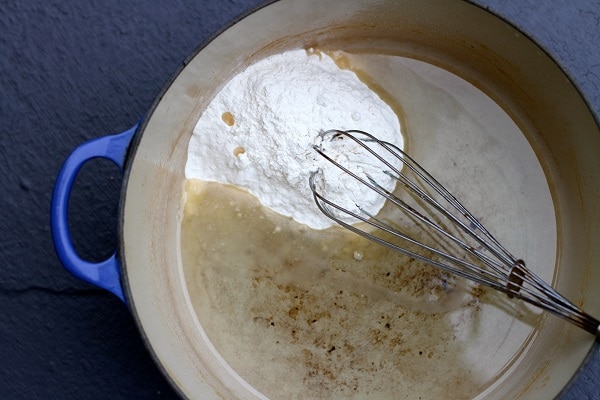
- Pull three cold beers out of the fridge, set aside the stove, open one, and take a sip. Ahhhhhh.
- Place a heavy-bottomed, cast-iron enameled Dutch oven on the stove, over a low flame.
- Measure (by weight and not volume) equal parts of flour and oil. In this instance, 8 ounces of flour and 8 ounces of oil. Add the mixture into the pot.
- Take another sip of the beer.

- Using a whisk, constantly mix and stir the mixture (careful not to splatter on your skin – they don’t call roux Cajun napalm for nothing) until it foams and slowly starts to turn a light caramel color (about 10 minutes). If the mixture begins to bubble or pop – immediately remove from the heat.

- Continue to stand, stir, and keep close eye over the roux (that’s why I told you to get the beers out of the fridge to keep you occupied) until it reaches a rich brown/reddish color – approximately 45-70 minutes. Tip: start out low and slow. After you’ve had experience, you can always increase your heat to speed up the process.
- If it burns, i.e. little black specs appear – throw it out and start over. Seriously – a burnt roux will cause the entire dish to be bitter and off in taste.
Of course, there are variations on the classic method, although I believe that doing things the hard way, as described above, just makes things manlier. Besides, the beer tastes good.
Dry Roux
Some people feel strongly about eliminating the fat (which I suppose reduces some calories). This method simply calls for whisking the flour around the dry pot (sans any fat) until the flour toasts to a dark brown color. Again, be patient and keep close watch over the pot – maintaining a low heat throughout the process.
Baked Roux (Alton Brown method)
Perhaps one of Alton Brown’s greatest scientific contributions to the world of food is his no-fail, oven-baked roux. Instead of standing and constantly stirring, Brown endorses mixing together the fat and flour (uncovered Dutch oven), and placing it onto the middle rack of a preheated oven at 350 degrees F. Stir every half hour or so, until a dark/red brown color is reached – about 90 minutes. Add additional 15-minute increments if needed. This method, although slower, is nice because it allows you to prep, chop, clean, etc. while the oven takes the work out of stirring the pot.
No Roux
Some (generally Creoles) believe gumbo can be made without any type of roux whatsoever. I am not one of those people, therefore I’m omitting any further explanation.
The Trinity
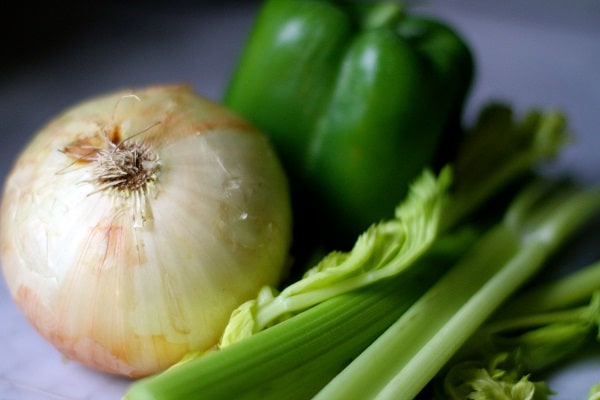
Once the roux has reached your desired color, it’s time to add the onion, celery, and bell pepper, otherwise known as the trinity in Acadian cooking. Unlike the French mirepoix (onions, celery, and carrots), the trinity is something you’ll find as a base in gumbos, étouffées, jambalaya, maque choux, and many other traditional favorites.
The key is to add the trinity into the hot roux, which instantly begins to break down the vegetables. As an added benefit, the vegetables begin to temper the roux – which means you don’t have to worry as much about it burning while it continues to develop a richer, darker flavor.

Although not considered part of the trinity, this is also the time to add heaping amounts of chopped garlic – usually about 10-15 minutes after the trinity has been added to the roux. The garlic is stirred unto the mixture until it begins to smell fragrant, about 2 minutes. Add in some seasoning, and your house is most likely beginning to smell like a Louisiana kitchen.
Tomato?
I’ve made reference to Creole and Cajun a few times, but it’s probably easiest to think of these terms as city and country folk, respectively. My gumbo shares both Creole and Cajun attributes, whereas others draw a fine line amongst the different influences. One of those is the addition of tomato – something proud Cajuns would never add to their pot. That’s okay, I’m neither Creole nor Cajun, so I’m just fine with adding a bit of chopped tomato into my trinity roux mixture. In my opinion, the tomato adds a nice depth of acidity and bite to the finished product.
Stocks and Seasonings
Once the trinity and roux mixture have had time to meld, its time to deglaze the pot with a strong, amber beer (Abita Amber is my go-to choice). Use a wooden spoon to scrape up any of the browned bits from the bottom of the pot.
Meanwhile, it’s time to whisk in about 6 cups or so of hot cooking stock, in one-cup increments. Of course, my stock choice is based on the type of gumbo I’m making. Chicken and sausage gumbo = chicken stock. Turkey and sausage gumbo = turkey stock. Seafood gumbo = seafood stock. Venison gumbo = venison/beef stock. You get the idea.
Once the stock has been added, I add on to the initial salt and pepper seasoning I typically started during the trinity stage. Now is the time to add elements of paprika, cayenne pepper, red pepper, bay leaf, and maybe even the slightest pinch of oregano. Of course, you can always add several shakes of a catch-all Creole seasoning such as Tony Chachere’s. For darker gumbos, I like to add in a dash or two of Worcestershire sauce to add that umami element. And lastly – you gotta have some Louisiana Hot Sauce; a tablespoon or two should do you just fine.
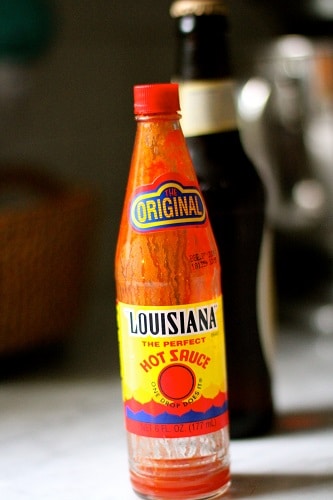
Bring the mixture up to a slow simmer and cook for as little as 30 minutes, up to a couple of hours, skimming the surface as needed.
Okra vs. Filé
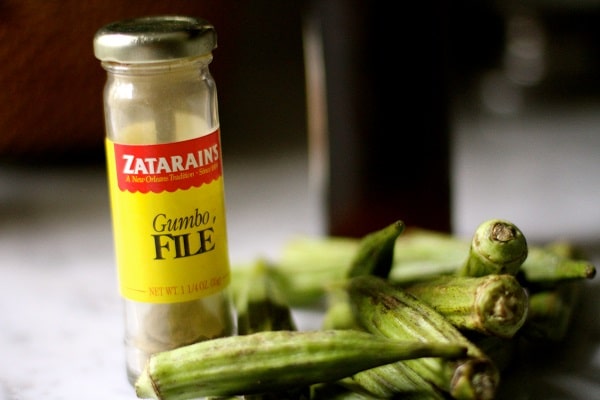
This is where the debate really starts to get interesting. There are those with the opinion that gumbo ain’t gumbo without the okra, others who believe that okra has no place in the dish (filé enthusiasts), and still others who endorse a combination of the two. I’m either/or, but never both. To be honest – I use one or the other depending on the type of gumbo I want to make.
The common denominator between the two is that both impart their own unique flavor, while serving as a thickening agent to the dish.
To keep things orderly, now would be the time to add the okra to the pot – preferably seared off a bit in cast-iron prior to adding, as it deepens the okra flavor. The okra is simmered in the stock until just tender, lending its earthy flavor while thickening the dish at the same time. I often prefer to use okra with my darker, richer gumbos.
Filé is an entirely different ballgame. A finely ground powder made from sassafras leaves, filé has a lemony, almost bitter taste. It should be added “off the heat,” or after the dish has finished cooking. In fact, it’s often served tableside as a topping, much like salt and pepper. When stirred into the pot, it also has a thickening effect, and I find it more useful in gumbos featuring a lighter roux and seafood.
Contents

There’s not much debate on this subject, as virtually any meat or seafood can find its way into a gumbo: fish, crabs, shrimp, crawfish, oysters, chicken, turkey, quail, duck, sausage, venison, and so on. Literally, gumbo was created and evolved as a hearty stew to make use of whatever was on-hand – sourced from the bayou, killed in the wild, or raised on the farm.
One of my only opinions regarding contents is the use of Andouille sausage over any other form. This is a special smoked pork sausage that includes ingredients such as garlic, onion, salt, red/cayenne/black pepper, wine, and other seasonings. It’s a fantastic addition to any gumbo, or when grilled and served alongside Creole mustard.
Toppings
The most common topping for a steaming bowl of gumbo is hot cooked rice. I prefer to go easy on the rice – it’s just there to add an extra umphhh. It shouldn’t distract from the stew that you’ve been brewing now for several hours. To garnish, I typically toss on some sliced scallions, a shake of Cajun seasoning, and maybe a glug or two of Louisiana Hot Sauce.
Not all folks subscribe to the rice topping. Those folks in the northern parts of Louisiana swear by finishing their gumbo with potato salad – of the mustardly make, of course.
Lastly, as mentioned before, filé is another common topping or garnish for gumbos not containing okra.
Shrimp + Crawfish Gumbo Recipe

Let’s put everything together with the following recipe. Take note of some of my choices, per the guidelines above. Most grocers will sell frozen crawfish tail meat by the pound, or you can order it online at various Cajun specialty stores. If you can’t find the crawfish, simply double your quantity of shrimp.
Prep: 30 mins
Cook: 90-120 mins
Serves: 6-8
Ingredients
- 1 lb. Andouille sausage, cut crosswise into ¼-inch-thick slices
- 3 cups okra, cut into ½-inch slices
- 8 oz. vegetable oil/butter/shortening
- 8 oz. all purpose flour
- 1 large onion, finely diced
- 1 large bell pepper, finely diced
- 3 celery stalks, finely diced
- 1 Tbsp. Creole seasoning
- 1 14.5 oz. can petite diced tomatoes
- 1 amber beer
- 1 Tbsp. Louisiana Hot Sauce
- 2 bay leaves
- ½ tsp. cayenne pepper
- 6 cups seafood stock, warmed
- 1 lb. medium shrimp, peeled and deveined
- 1 lb. crawfish tail meat
- Hot cooked rice
- Scallions, sliced
Directions
- Preheat a Dutch oven over medium heat. Add sausage and cook until browned; remove and set aside on a plate. Next, add okra and sauté until just slightly charred, about 3-4 minutes; remove and set aside on a plate.
- Combine oil and flour, stirring constantly, to make a dark brown roux, about the color of chocolate; 45-70 minutes. Add the onions, peppers, celery, and Creole seasoning; sauté until tender, about 8-10 minutes. Add tomatoes, followed by the beer. Next, add the hot sauce, bay leaves, and cayenne pepper. Finally, whisk in the seafood stock, one cup at a time. Bring the mixture to a slow boil.
- Reduce heat to low, cover and simmer for 30 minutes, up to a few hours, skimming the fat/foam as necessary. Add sausage and okra back into the pot, cover and simmer for 10-15 minutes, or until okra is just cooked through. Add the shrimp and crawfish; stir to make sure the seafood is immersed in the liquid.
- Turn off heat, cover, and allow the seafood to gently cook for 10-15 minutes. Shrimp and crawfish tail meat should be firm and bright in color.
- Serve in bowls topped with white rice and garnished with sliced scallions.
Share your family’s tradition, method, or recipes in the comments below.







